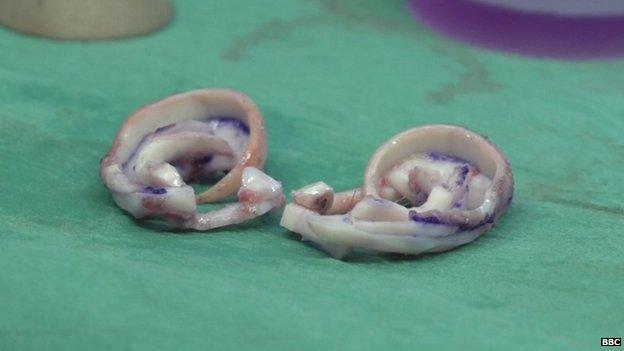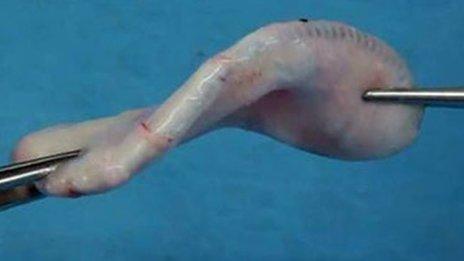Boy has ears created from ribs
- Published
- comments
Kieran, his family and his surgeon, before, during and after the operation
A boy who was born without ears has had a pair created from his ribs.
Nine-year-old Kieran Sorkin had the surgery at London's Great Ormond Street Hospital.
About 100 children a year in the UK are born without one or both ears, a condition known as microtia.
Kieran was born deaf with small lobes where his ears should be. He can already hear, thanks to previous surgery to implant a hearing aid.
"I want people to stop asking me questions", said Kieran from Hertfordshire. "I'd like just to look like my friends.
"I'd also like to be able to wear sunglasses and earphones."
Kieran's mum Louise Sorkin said: "He's a very sociable boy and has longed for this operation for years.
"I don't want children bullying him because he's different. I just want him to be accepted like everyone else."
On the morning of the operation, consultant plastic surgeon Neil Bulstrode stencils the shape of Louise Sorkin's ears.
He said: "When a patient has one ear we can match the new ear to that. Fortunately Kieran's mum has very pretty ears so that should work well."
Psychological benefits
In theatre the surgical team remove cartilage from six of his ribs. It is cut, shaped and sewn.

Kieran's ears were shaped from cartilage taken from his ribs
These frameworks are inserted in pockets in the skin and then using suction, they take on the shape of an ear on both sides.
Great Ormond Street Hospital does about 40 of these operations each year, although most of those are to create one missing ear.
The surgery is cosmetic, not to improve hearing. But Mr Bulstrode said it brings huge psychological benefits.
"If you can change the confidence of a patient at this young age, you can change their whole trajectory in life.
"You see this when they come back. It's a huge boost for them."
Tissue engineering
Advances in tissue engineering mean that this kind of reconstructive surgery could be done quite differently within a decade.
Scientists at the Institute of Child Health (ICH), part of University College London, are creating stem cells from patients' fat tissue.
The Institute, which is Great Ormond Street Hospital's research partner, induces the cells to make cartilage or bone.
Dr Patrizia Ferretti, leader of the ICH's Development and Regeneration Group, who is leading the study, said: "This approach would be far less invasive for a child than the current method of harvesting a child's rib cartilage."
Last year scientists in the US implanted a human-like ear, grown from cow and sheep cells, onto a rat.
But such research is still at its early stages, and for the foreseeable future children needing new ears will benefit from the same procedure used at Great Ormond Street Hospital.
Three days after surgery, Kieran is given a mirror to look at his new ears.

Kieran is delighted with his new ears
His first reaction was "Wow!". Kieran started to giggle, but the operation on his ribs means it hurts when he laughs.
Kieran will need a second operation in six months to make his ears stand out from the scalp more, but he's already delighted with the result.
- Published31 July 2013
